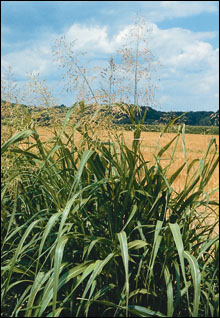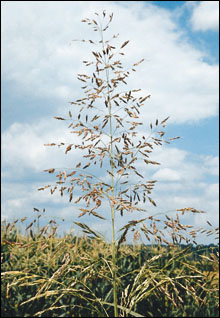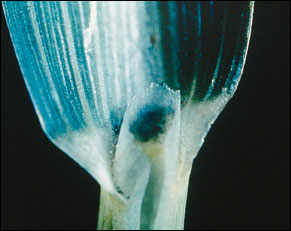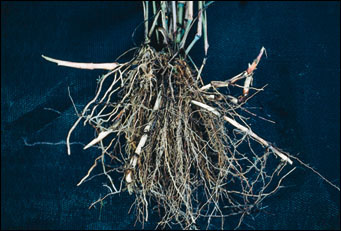Johnsongrass (Sorghum halepense) is a troublesome perennial grass weed that reduces yields in corn, grain sorghum, soybean, cotton and leguminous forages. Originally introduced into the United States as a forage crop, it is now an agricultural pest in most states south of the 42nd parallel. Dense johnsongrass infestations severely limited corn production until the relatively recent introduction of Accent and Beacon herbicides. Several states have legislation requiring eradication or control programs. Johnsongrass is listed as a noxious weed by the Missouri Department of Agriculture, which requires that landowners take steps toward controlling and eradicating the weed on all property owned or under their control.
Growers now have numerous tools to manage this weed. As with most other weeds, the key is to implement multiple control strategies when johnsongrass is first observed and not wait until it is firmly established.
Plant characteristics


Johnsongrass is well adapted to compete with crop plants and to spread to new areas. An upright perennial, it often grows 6 to 8 feet tall (Figure 1). It has wide leaves with thickened whitish midribs; its panicles (seed heads) are open (Figure 2), and the many branches support thousands of spikelets from which seeds are readily shattered. A key identifying characteristic of the vegetative stage is its relatively large, jagged-edged, membranous ligule (Figure 3). Shattercane can easily be confused with johnsongrass. The most obvious difference is that since shattercane is an annual grass, it does not produce rhizomes. The leaf blade of shattercane, as much as 3 inches wide, is usually much wider than the 0.8-inch-wide leaf blade of johnsongrass. In addition to a typical fibrous root system, johnsongrass produces thick cream-colored rhizomes, covered with orange scales (Figure 4).


During 1992 various biotypes of johnsongrass in Mississippi were reported to exhibit resistance to Fusilade DX applied at labeled rates. Resistance appeared in fields that had been treated with Fusilade and Poast Plus in at least eight of the previous 10 years. Since that time, at least five counties in Mississippi have johnsongrass populations confirmed resistant to Fusilade, and there are recent reports of resistant johnsongrass in Kentucky. Commonly, resistant populations of johnsongrass are not sensitive to Fusilade DX or Assure II, no matter what rate is applied. Elevated tolerance to Poast/Poast Plus has also been noted, but rates three- to fivefold higher than recommended normally are effective. Field use rates of Select, another selective grass herbicide, are effective in controlling resistant johnsongrass.
Propagation
Its ability to produce seed and rhizomes and spread to uninfested areas contributes to making johnsongrass a menacing weed. Rhizomes are extensive and are produced in the top 10 inches of soil but have been found at depths of 5 feet. Johnsongrass readily reproduces from rhizomes and seed; seedling plants can initiate rhizomes as few as 19 days following emergence.
A single plant may produce more than 80,000 seeds in a single growing season, and 275 feet of rhizomes. Seeds shatter easily and fall to the ground beneath plants that produce them. Instead of germinating uniformly, seeds can remain dormant and produce plants over several years. Johnsongrass seed can remain viable in the soil for more than 10 years.
Johnsongrass generally grows in fertile bottomlands along creek and river banks and in upland fields. Irrigation ditch banks are also overgrown with johnsongrass, and seed is carried by the water. In a new location, johnsongrass spreads rapidly and soon becomes a serious problem. Tillage equipment can spread the rhizomes, and birds spread the seed.
Agricultural seed, hay and various livestock feeds sometimes become contaminated with johnsongrass seed. In the past, watermelons shipped from the South were often bedded in johnsongrass hay, which was swept out at various dropoff points and contributed to its spread.
Interfertility with other sorghum species
Plant breeders, seed dealers and growers often observe off-type plants or "rogues" of hybrid grain sorghum. Common rogues are the tall outcrosses to sudangrass, johnsongrass or other sorghum types. Sorghum outcrosses with johnsongrass as the male parent often have rhizomes resembling those of johnsongrass. Johnsongrass-grain sorghum hybrids can become a significant weed threat.
Cultural control
Preventing johnsongrass from becoming established in new areas is the best available control method, because the weed spreads in so many ways. Because johnsongrass is a perennial weed, single cultural control measures or herbicide applications rarely provide adequate control.
Johnsongrass control programs should
- Prevent spread of rhizomes from infested to uninfested areas.
- Kill or weaken established plants and their underground rhizome system.
- Control seedlings originating from shattered seed.
- Prevent production of seed and its spread to new areas.
- Use fall tillage to bring rhizomes to soil surface, where they may be killed by winter conditions.
These objectives are closely related and are equally important to the success or failure of a control program. In limited infestations, it is possible and desirable to use herbicides to kill the weed and prevent seed production. The critical time to kill johnsongrass is while the weed is becoming established and before it has spread over the entire field. For sites with established infestations, a fall application of Roundup or Touchdown will kill emerged tissue and often developing rhizomes.
Growing early-maturing crops, plowing immediately after harvest, and tilling as needed are common methods to break up rhizomes and weaken johnsongrass stands in cultivated areas. Johnsongrass responds to tillage like most tough perennial weeds. Intensive tillage will suppress rhizome johnsongrass. Moderate tillage will break and spread rhizomes and allow johnsongrass to thrive. Johnsongrass will spread relatively slowly in true no-till regimes; however, given enough time, infestations may still become severe. Severe infestations often result in pastures converted to row crops. Uncontrolled johnsongrass in fence rows and ditch banks is a common source of johnsongrass seed as well as vegetative encroachment into fields. Spot sprays on fences and ditch banks can eliminate these sources of seeds and rhizomes.
Alfalfa competes well with johnsongrass for a limited time but will eventually weaken. Repeated mowing of an alfalfa-johnsongrass mixture will prevent johnsongrass from producing seed and will inhibit rhizome development. Intensive grazing and mowing can be used to reduce a stand of johnsongrass. If grazed or mowed closely for at least two years, the plants become weak and stunted and the rhizomes become concentrated near the soil surface. Plowing in late fall exposes the rhizomes to low winter temperatures and reduces the stand considerably. For infested areas that cannot be tilled or sprayed, intensive grazing or mowing is probably the best control.
Johnsongrass control with herbicides
To reduce johnsongrass infestations with herbicides, it will be necessary to use an integrated approach consisting of soil-applied herbicides, postemergence herbicides, crop rotation and tillage. Weedy plants such as johnsongrass adapt quickly to a cultural system that does not change from year to year. An example of this type of system is continuous soybean production such as occurs in many river and creek bottoms. Crop rotation is important to disrupt the physical environment that johnsongrass and many other weeds live in and will help to minimize seed and rhizome production. Herbicide rotation is important to minimize selection pressure for herbicide-resistant biotypes.
The programs mentioned below are designed to control other weeds in addition to johnsongrass. However, these programs are designed for fields where johnsongrass is not adequately controlled by current methods. For control methods to be effective, growers must be diligent and apply control techniques as often as necessary.
Corn
In no-till corn production, any herbicide that has postemergence grass activity will provide some control of seedling johnsongrass. In conventional-till corn production, Eradicane or another product containing EPTC (Eradicane) can be applied as a preplant incorporated treatment. Rhizomes should be cut up into small pieces using several diskings before treatment. Incorporate Eradicane immediately after application to minimize volatility losses. However, the burndown or preplant incorporated applications will not provide adequate season-long control and additional control measures will be needed.
Postemergence herbicides for johnsongrass control in corn include Accent, Beacon, Poast HC and Roundup Ultra. The initial application of Accent or Beacon should be applied to 4- to 10-inch-tall seedling johnsongrass and 8- to 14-inch-tall rhizome johnsongrass. If regrowth occurs, a second application can be made when johnsongrass regrowth is 8 to 14 inches tall. Accent can be applied as a broadcast treatment on corn until it is 24 inches tall. Accent applications can be made to 24- to 36-inch corn by using drop nozzles. Beacon can be applied as a broadcast spray to corn that is between 4 and 20 inches tall. Do not apply Accent or Beacon to corn that has been treated with Counter insecticide. Consult the label for restrictions with other organophosphate insecticides and postemergence herbicides.
In SR (sethoxydim-resistant or Poast-tolerant) corn, Poast Plus or Poast HC should be applied initially to 10- to 25-inch johnsongrass. If regrowth occurs, a sequential treatment can be applied to 12-inch johnsongrass regrowth. There are no insecticide restrictions and Poast HC can be applied until corn begins to shed pollen.
When Roundup-Ready corn has received full federal approval, Roundup Ultra can be applied to johnsongrass up to 24 inches tall. If regrowth occurs, a sequential treatment can be applied to 12-inch johnsongrass regrowth. Consult the label for stage of growth and insecticide restrictions.
Soybean and cotton
In no-till soybean or cotton production, as in corn production, any herbicide that has postemergence grass activity will provide some control of seedling johnsongrass. In conventional-till soybean or cotton production, Treflan and Prowl can be applied preplant incorporated and will provide some control of seedling johnsongrass. When incorporating these herbicides, set the implement to run 4 inches deep and make two passes over the treated area to ensure adequate mixing of the herbicide with the soil. However, as in corn production, the burndown or preplant incorporated applications will not provide adequate season-long control, and additional control measures will be needed.
Postemergence herbicides for johnsongrass control in soybean and cotton include Assure II, Bugle, Fusilade DX, Fusion, Poast Plus/Rezult G/Conclude G, and Select in regular, non-herbicide-tolerant soybean or cotton. All of these herbicides provide acceptable control, although Assure II, Fusilade and Select are the preferred herbicides for johnsongrass. Roundup Ultra can be used in Roundup-Ready soybean and cotton. In dense infestations, single applications of any of these herbicides will provide incomplete control. Better control is obtained with split applications. It is recommended that the lower herbicide rates be used on seedling johnsongrass that is less than 10 inches tall. The higher rates are recommended for use on rhizome johnsongrass taller than 10 inches. The recommended approach is to target johnsongrass that is 10 to 18 inches tall. Smaller johnsongrass has little leaf area and consequently absorbs limited amounts of herbicide for complete rhizome control. Regrowth after the first postemergence application indicates that there is a significant amount of rhizome johnsongrass present in the field, and a second postemergence application will be needed. To control regrowth, apply the higher rate of a postemergence herbicide to regrowth that is 6 to 12 inches tall. For regrowth applications, it is a good idea to use a different herbicide than that used for the initial application to avoid selection of herbicide-resistant johnsongrass biotypes.
Adjuvants and cultivation in corn, soybean and cotton
Consult the manufacturer's label for the appropriate adjuvant for postemergence herbicides. Allow seven days after postemergence herbicide applications before any cultivation is practiced. Cultivation too soon after herbicide applications will reduce johnsongrass control as stems and rhizomes are broken before the herbicide can be translocated. Cultivation seven to 10 days after herbicide applications, after the herbicide has translocated, will further weaken the herbicide-injured rhizomes and increase johnsongrass control.
Alfalfa, birdsfoot trefoil, clovers
A preplant incorporated treatment of Balan can be used for control of seedling johnsongrass and other annual grasses in alfalfa. Rhizome johnsongrass will not be adequately controlled with Balan alone. Balan must be incorporated within four hours after application. Variable weed control may result if incorporation is delayed more than eight hours.
Postemergence herbicides include Poast/Poast Plus and Select. These herbicides can be used on new or established seedings and can also be applied when alfalfa is either dormant or nondormant. Apply Poast, Poast Plus or Select to 10- to 25-inch-tall johnsongrass. If regrowth occurs, sequential applications can be made with similar rates to 12-inch johnsongrass regrowth. Consult the label for the appropriate adjuvant for the postemergence herbicides.
Grain sorghum
Because johnsongrass is closely related to other plants in the sorghum family, including grain sorghum (Sorghum bicolor), current herbicides that control johnsongrass also control or kill grain sorghum. The best management practice for johnsongrass control in grain sorghum will be to grow an alternative crop that has more available registered herbicides.
Selective herbicide applications for johnsongrass control
Selective application equipment can provide economical johnsongrass control in any of the above-listed crops. Typical johnsongrass infestations are distributed unevenly across the field. Chemical costs can be reduced by using a ropewick applicator or by spot spraying the infested areas. In a ropewick applicator, mix 1 part Roundup or Touchdown with 2 parts water. Run the ropewick applicator in two directions across the field so the johnsongrass is wiped or wicked on both sides. The ropewick should be safely run above the crop canopy to avoid contact with crop foliage. Some dripping and crop injury is inevitable; therefore, it is best to use a commercially available ropewick bar designed to minimize dripping.
Spot spraying can also be an economical johnsongrass management tool. In soybean and cotton, the selective grass herbicides mentioned earlier may be mixed with water in a 1 to 2 percent solution and spot sprayed with hand wand, ATV-mounted sprayers, or tractor-mounted sprayers. Roundup or Touchdown spot sprays can also be used but will cause injury or death to crops that are not tolerant of glyphosate herbicides (Roundup or Touchdown).
Preharvest johnsongrass control
Johnsongrass control before harvest will help to reduce rhizome and seed production for subsequent rotational crops. Roundup is labeled for application to mature corn, cotton, grain sorghum, soybean, and wheat. Double-crop soybean may particularly benefit if johnsongrass is sprayed in the preceding wheat crop. Roundup may be applied to standing soybean that has lost all green color in the pods as long as the crop is not being grown for seed. Roundup may be applied to corn at 35 percent grain moisture or less, to cotton when 60 percent of the bolls are open, to grain sorghum at 30 percent moisture or less, and to wheat after the hard-dough stage.
Soybean and wheat should not be harvested for seven to 10 days after application to allow herbicide translocation. These applications may be of limited utility in soybean and cotton, as the application time is typically close to frost. Unless herbicide applications are made at least seven to 10 days before frost, insufficient translocation will occur and the applications will not be effective.